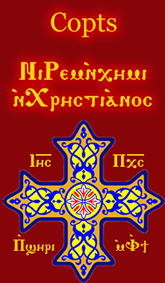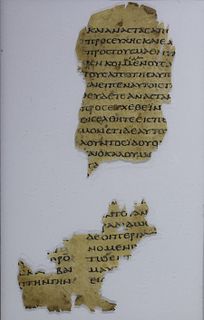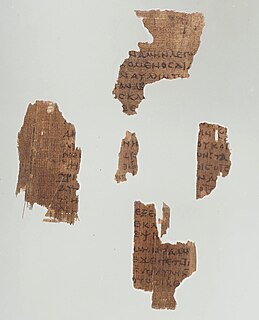Related Research Articles

There have been many Coptic versions of the Bible, including some of the earliest translations into any language. Several different versions were made in the ancient world, with different editions of the Old and New Testament in five of the dialects of Coptic: Bohairic (northern), Fayyumic, Sahidic (southern), Akhmimic and Mesokemic (middle). Biblical books were translated from the Alexandrian Greek version.

Uncial 0171, ε 07 (Soden) are two vellum leaves of a late third century Greek uncial Bible codex containing fragments of the Gospel of Matthew and the Gospel of Luke. Luke fragment, in two parts, is preserved in the Laurentian Library collection in Florence, and the Matthew fragment is in the Berlin State Museum.

Codex Borgianus, designated by T or 029, ε 5, is a Greek and Sahidic uncial manuscript of the Gospels, dated palaeographically to the 5th century. The name of the codex came from its former owners.
Uncial 086, ε 35 (Soden), is a Greek — Coptic diglot, uncial codex of the New Testament, dated paleographically to the 6th century.
Uncial 0100, ε 070 (Soden), is a Greek-Coptic diglot uncial manuscript of the New Testament. It is dated palaeographically to the 7th-century.

Papyrus 6, designated by 𝔓6 or by ε 021, is a fragmentary early copy of the New Testament in Greek and Coptic (Akhmimic). It is a papyrus manuscript of the Gospel of John that has been dated paleographically to the 4th century. The manuscript also contains text of the First Epistle of Clement, which is treated as a canonical book of the New Testament by the Coptic Church. The major part of the codex is lost.
Uncial 0126, ε 36 (Soden), is a Greek uncial manuscript of the New Testament, dated palaeographically to the 8th-century.
Lectionary 1575, α 1037 (Soden), is a Greek-Coptic diglot lectionary manuscript of the New Testament, dated paleographically to the 9th-10th century.

Uncial 0184, is a Greek-Coptic diglot uncial manuscript of the New Testament, dated paleographically to the 6th century.
Uncial 0200, is a Greek-Coptic diglot uncial manuscript of the New Testament, on parchment. Palaeographically it has been assigned to the 7th century. The manuscript has survived in a very fragmentary condition.
Uncial 0201, is a Greek uncial manuscript of the New Testament, dated paleographically to the 5th century.
Uncial 0204, is a Greek-Coptic diglot uncial manuscript of the New Testament, dated paleographically to the 7th century.
Uncial 0260, is a Greek-Coptic uncial manuscript of the New Testament. Palaeographically it has been assigned to the 6th century. The manuscript has survived in a very fragmentary condition.

Uncial 0269, ε 83 (Soden), is a Greek uncial manuscript of the New Testament. Paleographically it has been assigned to the 9th century.
Uncial 0298, is a Greek-Coptic uncial manuscript of the New Testament. Palaeographically it has been assigned to the 8th or 9th century.
Uncial 0299, is a Greek-Coptic diglot uncial manuscript of the New Testament. Palaeographically it has been assigned to the 10th or 11th century.
Minuscule 103, ΟΘ28 (Soden), is a Greek minuscule manuscript of the New Testament, on parchment leaves. Palaeographically it has been assigned to the 12th century. The manuscript has complex contents.
Lectionary 6, designated by siglum ℓ6. It is a Greek-Arabic diglot manuscript of the New Testament, on paper leaves, dated by a colophon to the year 1265.
Uncial 0320, is a diglot Greek-Latin uncial manuscript of the New Testament on parchment. Palaeographically it has been assigned to the 10th-century. Formerly it was designated by Dabs2. The manuscript is very lacunose.
Editio Octava Critica Maior is a critical edition of the Greek New Testament produced by Constantin von Tischendorf. It was Tischendorf's eighth edition of the Greek Testament, and the most important, published between 1864 and 1894.
References
- 1 2 J. K. Elliott, A. Greek – Coptic (Sahidic) fragment of Titus - Philemon (0205), Novum Testamentum XXXVI, 2 (1994), pp. 183-195.
- 1 2 3 Aland, Kurt; Aland, Barbara (1995). The Text of the New Testament: An Introduction to the Critical Editions and to the Theory and Practice of Modern Textual Criticism. Erroll F. Rhodes (trans.). Grand Rapids: William B. Eerdmans Publishing Company. p. 125. ISBN 978-0-8028-4098-1.
- 1 2 "Liste Handschriften". Münster: Institute for New Testament Textual Research. Retrieved 23 April 2011.
- ↑ Codex 0205 (GA) LDAB
- ↑ Kurt Aland (1963). Kurzgefasste Liste der griechieschen Handschriften des Neuen Testaments. Berlin: Walter de Gruyter. p. 10.
- ↑ Aland, Kurt; Aland, Barbara (1995). The Text of the New Testament: An Introduction to the Critical Editions and to the Theory and Practice of Modern Textual Criticism. Erroll F. Rhodes (trans.). Grand Rapids: William B. Eerdmans Publishing Company. p. 74. ISBN 978-0-8028-4098-1.